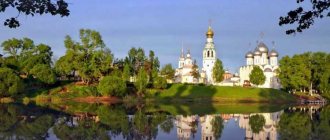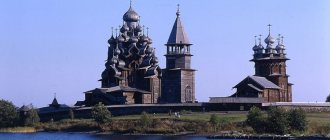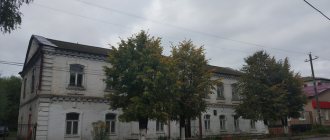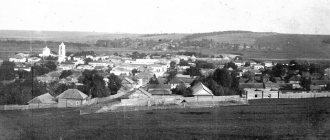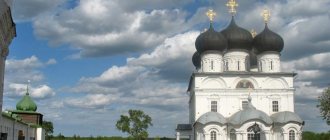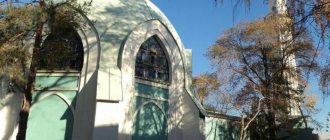Historical Krasnoyarsk: 10 oldest architectural monuments of the city
Krasnoyarsk is a city with a rich history and unique architecture. Despite the fact that many historical buildings have been lost without a trace, in the capital of Siberia there are still preserved objects whose age is rapidly approaching the figure of 200. The editors of the KrasnoyarskMedia news agency have collected 10 of the oldest architectural monuments of Krasnoyarsk, which have managed to survive to this day.
1. Holy Intercession Cathedral , year of construction: 1795
Holy Intercession Cathedral. Photo: culture.ru
The Holy Intercession Cathedral can be called the oldest stone building in Krasnoyarsk - construction of the cathedral began a year after the fire in 1773, when the fire destroyed most of the wooden buildings, including the famous Krasnoyarsk fort and the Intercession Church.
It is worth noting that in 1774 they also began to build a wooden church. Permission to erect a stone structure was received from the Tobolsk Consistory only 10 years later. Most of the construction work was completed by 1789, and the final result of construction was summed up in 1795, when the Holy Intercession Cathedral began to function.
Over the years of its existence, the cathedral has undergone minor changes. The most extensive reconstruction of the facade was carried out in the middle of the 19th century. In the 21st century, the cathedral was whitewashed and the roof was repainted blue. 5 years ago the color of the roof changed to green.
2. House of merchant Terskov , year of construction: 1817
House of the merchant Terskov. Photo: naov.ru
The architectural monument, which is located on Mira Avenue, 29, belonged to the merchant of the second guild Andreyan Prokopyevich Terskov. In the period from 1820 to 1822, the merchant served as the head of the city and also owned a store, which was located on the ground floor of the house.
In 1800, the house was badly damaged by fire. During the renovation, the stucco molding and decoration in the classicist style were removed from the façade, and the shape of the windows was changed to rectangular. Since then, the governor's council and many other institutions have visited the walls of the building.
3. Residential building of Potekhin , year of construction unknown
Potekhin's residential building. Photo: ookn.ru
The ancient house at 21 Weinbaum Street is one of the examples of wooden architecture. Despite the fact that the exact date of construction of the house is unknown, since 1823 the estate was owned by non-commissioned officer Lunev. In the second half of the 19th century, the house began to belong to the family of tradesman E.I. Potekhin.
On the night of April 18, 1881, due to the fault of a cab driver, the hayloft on the estate caught fire. Due to the storm, the fire quickly spread not only to the house itself, but also captured the buildings of the men's gymnasium and other nearby buildings. Then the fire burned down 542 wooden houses, 967 non-residential buildings, 47 stone houses, 16 forges, 12 tanneries and 4 soap factories. After the fire, the house was restored and since 1919 the family of tradesman S.I. lived here. Potylitsyn.
From 1941 to 1944, Professor Valentin Voino-Yasenetsky, known as Archbishop Luka, lived in Potekhin’s house. During this period, the professor published his famous works “Essays on Purulent Surgery” and “Late Resections for Infected Joint Wounds”
4. House of ministers of the Church of the Intercession , year of construction: 1828
House of Servants of the Intercession Church. Photo: ookn.ru
The cultural heritage site of regional significance is located at 45 Mira Avenue and originally belonged to the merchant I.A. Skolkov. After some time, the house briefly became the property of the Church of the Intercession, after which, in 1847, a photo salon was opened within the walls of the building. In the 1890s, the house also housed the provincial drafting studio. Since the beginning of the 20th century, the house became residential and only in the 2000s the first retail premises appeared here.
It is worth noting that over the years of its existence, the house of the ministers of the Intercession Church has undergone significant internal redevelopment. The facade remained almost unchanged, except that it was repainted, and the roof was completely replaced.
5. House of Vasily Surikov , year of construction: 1830
House-Museum of V.I. Surikov. Photo: ookn.ru
The house where the famous Krasnoyarsk artist Vasily Ivanovich Surikov was born and lived until 1868 was built in 1830 by his father I.V. Surikov. The architecture of the two-story house was typical of Siberian urban development of the 19th century, and on the territory of the estate there was a bathhouse, as well as a combined stable and barn. The Surikov family lived on the first floor of the house; due to financial difficulties, the second floor was rented out. In 1948, on the 100th anniversary of the artist’s birth, a museum was opened in the house.
Over the years of its existence, Vasily Surikov’s house has undergone minor changes, except that in 1900 the artist’s brother added an outbuilding to the building.
6. House of the Larionov estate , year of construction: 1830
House of the Larionov estate. Photo: naov.ru
The house, built in the style of Russian classicism, is located on Lenin Street, 3. An interesting fact is that the construction of a two-story brick house began in 1820 by order of the merchant P.F. Larionov, who at that time served as the head of the city. In 1830, after completion of construction, the house passed to the merchant's son Ivan Larionov. Also during this period, the wife of the Decembrist A.P. stayed at the estate. Yushnevsky Maria.
It is known that a partial redevelopment was carried out inside the house, and two windows on the first floor were cut out. Also, the roof of the house of the Larionov estate was completely replaced.
7. Main building of the former city hospital No. 1 , year of construction: 1845
Myasnikov's house. Photo: trk7.ru
The two-story brick building, which is located at 61 Mira Avenue, originally belonged to the family of gold merchant Nikita Myasnikov. However, 2 years after the completion of construction, the merchant died and his property was transferred to his older brother Ivan. Ivan Myasnikov himself also owned the estate for a short time and the last owner of the house was the Myasnikovs’ third brother, Nikolai. Like Nikita Myasnikov, Nikolai was a gold merchant, but he soon went bankrupt and, in an attempt to forge bills, ended up in hard labor.
From 1857 to 1862, the house housed the Rossiya Hotel, which was later renamed Amur. In 1864, the building was acquired by the Order of Public Charity and the residential building was converted into a hospital. Despite the fact that the main building remained almost unchanged, over the years a utility outbuilding, barracks for contagious patients and a home for the mentally ill appeared on the estate.
8. House of merchant S.F. Belova , year of construction: 1847
House of merchant Belov. Photo: Open sources
The mansion with elements in the Baroque style is located on Mira Avenue, 54. Construction of the house began between 1843 and 1844, immediately after the gold merchant Savely Fedorovich Belov acquired a plot of land from the townspeople Moskvitinov and Nashivoshnikov. Also S.F. Belov became one of the first merchants in Krasnoyarsk, in whose residential buildings shops were opened on the ground floor.
It is worth noting that the mansion acquired its familiar appearance to all Krasnoyarsk residents after 1881, when the façade in the style of late classicism was badly damaged in a fire. After renovation, the mansion now has a two-level wooden extension and stucco decoration, which has survived to this day.
9. Holy Trinity Cathedral , year of construction: 1848
Trinity Church. Photo: temples.ru
The Holy Trinity Cathedral, also known as the Trinity Church, is located on Igarskaya Street, 6 and the reason for its construction was the transfer of the cemetery from the now lost Church of All Saints (the territory of the modern shopping center "Kvant") to the shore of the Kachi. The construction process of the cathedral took place in two stages: in May 1836, the cold church was laid. Three months later, permission was received to build a warm chapel, which in 1842 was consecrated in the name of St. Innocent of Irkutsk. In October 1848, after construction was completed, the cathedral was re-consecrated.
It is worth noting that burials in the new Trinity Cemetery began even before the construction of the cathedral was completed: the oldest burial that has survived to this day dates back to 1843. In 1960, the sacristy of the Trinity Cathedral became two-tiered, and the wooden floors were replaced with mosaic ones.
10. Chapel of Paraskeva Pyatnitsa , year of construction: 1855
Chapel of Paraskeva Friday. Photo: travelask.ru
One of the main symbols of Krasnoyarsk, the Chapel of Paraskeva Pyatnitsa is located on the top of Karaulnaya Mountain. Since the founding of the city, there was a watchtower on this site, after which a wooden chapel was built in 1805, but the structure burned down in the 1840s. Thanks to the financial support of gold merchant Pyotr Kuznetsov, construction of the current chapel building began in 1852. In 1887, instruments for observing a solar eclipse appeared on the site near the chapel.
To date, the chapel building has undergone significant changes. After a fire in 1943, the chapel underwent major restoration work. Despite the fact that in 1980 the Chapel of Paraskeva Pyatnitsa received the status of an architectural monument of local significance, the building was abandoned until the early 1990s. In 1996, by order of the Russian Orthodox Church, the building was restored again - during this period, heating appeared in the chapel, the walls were painted with frescoes, and the dome became much larger.
Architecture of the Soviet period.
Oddly enough, the hands of Soviet architects did not particularly touch Krasnoyarsk, largely preserving its appearance from the times of Tsarist Rus'. But, nevertheless, several remarkable architectural structures of the Soviet period still appeared in the city.
The Communal Bridge over the Yenisei is the most important architectural structure for Krasnoyarsk, which is one of the most grandiose structures of the Soviet period. Construction of the bridge began in 1956 and continued until 1861. The example of the Stalinist Empire style is known throughout the world, and for the townspeople it serves as the most important transport route. The bridge carries as many as six lanes of traffic.
The Krasnoyarsk Opera and Ballet Theater is a fairly modern building that was erected between 1966-1978. The magnificent glass facade is the work of the famous Soviet architect I. Mikhalev, who designed this structure. The opening of the theater was dedicated to the 350th anniversary of the city, and to this day it is the main cultural center of life in Krasnoyarsk.
The Victory Memorial (1975) should also be classified as a city architectural landmark. Since this amazing memorial complex, built in honor of the Siberians-Krasnoyarsk people and the 30th anniversary of the end of the Great Patriotic War, is located in the historical part of the city, and is very popular among guests of Krasnoyarsk. Inside the building there is a museum dedicated to the war days and memorable events of those years.
